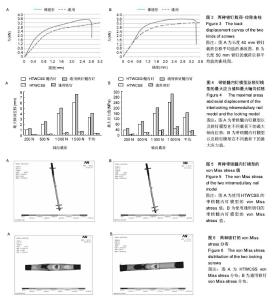| [1] Antekeier SB, Burden RL Jr, Voor MJ, et al. Mechanical study of the safe distance between distal femoral fracture site and distal locking screws inantegrade intramedullary nailing. J Orthop Trauma. 2005;19(10): 693-697.[2] Giannoudis PV, Papakostidis C, Roberts C. A review of the management of open fractures of the tibia and femur. J Bone Joint Surg Br. 2006;88:281-289.[3] Niedzwiedzki T, Brudnicki J, Niedzwiedzki L. Treatment of femoral shaft union disturbances with intramedullary nailing, Treatment failure. Orthop Trauma Rehab. 2007;9(4):377-383.[4] Hgel F, Gerber C, Bhren V, et al. Reamed intramedullary nailing of diaphyseal tibial fractures:comparison of compression and non-compression nailing. Eur J Trauma Emerg Surg. 2013;39:73–77.[5] Xavier F, Goldwyn E, Carrer A, et al. Influences of structural properties of the distal tibia on the compressive strength of interlocking screws for intramedullary nails, Bioengineering Conference (NEBEC). 2012 38th Annual Northeast, 2012: 129-130.[6] 冯卫,刘建国.交锁髓内钉治疗胫骨骨折研究进展[J]. 骨与关节损伤杂志, 2001,16(5):390-392.[7] 徐卫东,吴岳嵩,张春才,等.交锁髓内钉断裂的原因分析及对策.中国矫形版外科杂志,1999, 6(3):194-196.[8] Shih KS, Tseng CS, Lee CC, et al. Influence of muscular contractions ,on the stress analysis of distal femoral interlocking nailing. Clin Biomech.2008;23(1):38-44.[9] Wang LZ, Zhao F, Hao JY, et al. Biomechanical study on proximal femoral nailantirotation (PFNA) for intertrochanteric farture. J Mech Med Biol. 2012;12(4):1-13.[10] Bhat AK,Rao SK, Bhaskaranand K. Mechanical failure in intramedullary interlocking nails. J Orthop Surg(Hong Kong). 2006;(14):138-141.[11] Sancineto CF, Rubel IF,Seligson D,et al. Technique for removal of broken interlocking screws. J Orthop Trauma. 2001;15(2):132-134.[12] Krettek CK, Schandelmaier P, Tscherne H. Nonreamed interlocking nailing of closed tibial fractures with severe soft tissue injury. Clin Orthop. 1995;315:34.[13] Freedman EL, Johnson EE. Radiographic analysis of tibia fracture malalignment following intramedullary nailing. Clin Orthop. 1995;315:25.[14] Duwedlius PJ, Schmidt AH, Rubinstein RA, et al. Nonreamed interlocking intramedullary tibial nailing. Clin Orthop. 1995; 315:104.[15] Miyoshi S, Takahshi T, Ohtani M, et al. Analysis of the shape of the tibial tray in total knee arthroplasty using a three dimension finite element model. Clin Biomech. 2002;17(7): 521-525.[16] 梁旭,杨铁毅,张岩,等. 胫骨平台后外侧1/2骨折不同内固定方式的有限元分析[J]. 中国矫形外科杂志,2013,21(20):1353-1358.[17] Shih KS, Tseng CS, Lee CC,et al. Effects of distal nail-hole dimension and wall thickness on the femoral nailing stresses- Finite-element analysis. Biomed Eng. 2009;21(3):177-185.[18] Bhat AK, Rao SK, Bhaskaranand K. Mechanical failure in intramedullary interlocking nails,J Orthop Surg. 2006;14: 138-141.[19] Sancineto CF, Rubel IF, Seligson D, et al. Technique for removal of broken interlocking screws,J Orthop Trauma. 2001;15:132-134.[20] Shih KS, Tseng CS, Lee CC,et al. Influence of muscular contractions on the stress analysis of distal femoralinterlocking nailing. Clin Biomech. 2008;23(1):38-44. [21] Wieding J, Souffrant R, Fritsche A, et al. Finite element analysis of osteosynthesis screw fixation in the bone stock: an appropriate method for automatic screw modelling. PLoS One. 2012;7(3):3376.[22] Shih KS, Tseng CS, Lee CC. Influence of muscular contractions on the stress analysis of distal femoral interlocking nailing. Clin Biomech. 2008;23(1):38-44.[23] Horn J, Linke B, Hrntzsch D, et al. Angle stable interlocking screws improve construct stability of intramedullary nailing of distal tibia fractures: A biomechanical study injury. Int J Care Injured. 2009;40(7): 767-771. |

